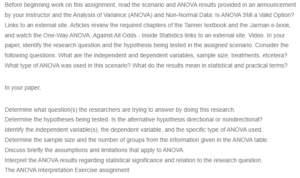ANOVA Interpretation Exercise
| Source | SS | df | MS | F | p |
| Between | 114.3111 | 2 | 57.1556 | 19.74 | <.0001 |
| Within | 121.6 | 42 | 2.8952 | ||
| Total | 235.9111 | 44 |
The Research Question
From the scenario, the researcher aims to compare the effectiveness of three techniques in memorizing information: mnemonics, imagery, and repetition. The researcher randomly assigns the participants to one of the three techniques to achieve this. Next, each participant group under each technique is provided a document to memorize within a given period. In addition, all participant groups are given a test. The research question the researcher is investigating is whether the three methods of enhancing memorization exhibit a significant difference in efficacy.
Hypotheses
- Null Hypothesis: There is no significant difference in the effectiveness of the three methods in enhancing memorization.
- Alternative Hypothesis: There is a significant difference in the effectiveness of the three methods in enhancing memorization.
The alternative hypothesis is nondirectional. As Salkind (2010) states, a nondirectional hypothesis indicates the likelihood of a difference, although it does not specify the direction of the difference; thus, it is nondirectional.
The Independent and Dependent Variables and the Type of ANOVA Applied in the Study
The dependent variable in the ANOVA analysis is the efficacy of the methods, while the independent variable is the three methods, which include repetition, mnemonics, and imagery. The effectiveness can be determined by evaluating the test scores attained by each group after the memorizing test. The analysis method is one-way ANOVA. Field (2018) points out that One-Way ANOVA determines whether significant differences exist between the means of three or more independent groups.
The Sample Size and Number of Groups from the ANOVA Table
The third row under the df column represents the sample size minus 1, that is, (N-1). Therefore, the sample size used in the research is (N+1)= (44+1) = 45 participants (Tanner, 2016). The first row under the df column also represents the total number of groups minus 1(t-1). Therefore, the total number of groups is (t+1) = 3.
The Assumptions and Limitations of the ANOVA Method
There are three primary assumptions in ANOVA. In this scenario, the responses from the variables are assumed to be normally distributed. Secondly, the distributions are considered to have equal variance. Thirdly, the variables and data points are considered to be independent. One of the limitations of ANOVA is that it is required to be applied for normally distributed data. When used for skewed data with longer tails, it might not yield reliable values (Gandhi, 2022). Besides, since ANOVA tests the alternatives to the null hypothesis, it may be unreliable when testing a single hypothesis. Gandhi (2022) also points out that when the losses in unknown population means are proportional to the square of the differences, it yields optimal results. In case of unproportionality, the outcome is not optimal.
Interpretation of the ANOVA Results Regarding Statistical Significance and the Research Question
The research revealed that there is a statistically significant difference in efficacy between at least two methods of enhancing memorization, as shown by F [(2, 42) = 19.74, p<0.0001]. The results are significant since the p-value is less than .05 at a 5% significance level. However, the analysis at this level does not indicate the groups bearing the difference and the direction of the difference. To obtain this information, Tanner (2016) suggests conducting post-hoc comparisons between the groups.
References
Field, A. (2018). Discovering Statistics Using IBM SPSS Statistics. (5th Ed.) Sage Publications.
Gandhi, Y. (2022). Analysis of Variance (ANOVA): Types and Limitations. Retrieved from https://www.analyticssteps.com/blogs/analysis-variance-anova-types-and-limitations
Salkind, N. (2010). Nondirectional Hypotheses. Retrieved from https://methods.sagepub.com/reference/encyc-of-research-design/n270.xml
Tanner, D. (2016). Statistics For the Behavioral & Social Sciences (2nd Ed.). Bridgepoint Education, Inc.
ORDER A PLAGIARISM-FREE PAPER HERE
We’ll write everything from scratch
Question
Before beginning work on this assignment, read the scenario and ANOVA results provided in an announcement by your instructor and the Analysis of Variance (ANOVA) and Non-Normal Data: Is ANOVA Still a Valid Option? Links to an external site. Articles review the required chapters of the Tanner textbook and the Jarman e-book, and watch the One-Way ANOVA: Against All Odds – Inside Statistics links to an external site. Video. In your paper, identify the research question and the hypothesis being tested in the assigned scenario. Consider the following questions: What are the independent and dependent variables, sample size, treatments, etcetera? What type of ANOVA was used in this scenario? What do the results mean in statistical and practical terms?

ANOVA Interpretation Exercise
In your paper,
Determine what question(s) the researchers are trying to answer by doing this research.
Determine the hypotheses being tested. Is the alternative hypothesis directional or nondirectional?
Identify the independent variable(s), the dependent variable, and the specific type of ANOVA used.
Determine the sample size and the number of groups from the information given in the ANOVA table.
Discuss briefly the assumptions and limitations that apply to ANOVA.
Interpret the ANOVA results regarding statistical significance and relation to the research question.
The ANOVA Interpretation Exercise assignment

